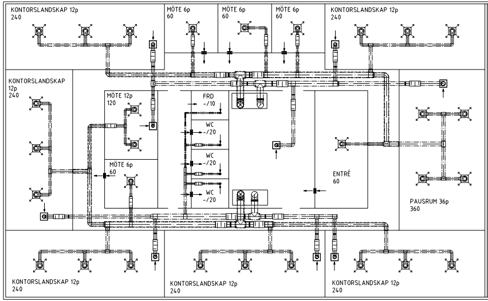Building in Detail
Office: New construction, 5,500 m2, 4 storeys, Stockholm.
Heating: District heating, radiators.
Cooling: Water-cooled chiller.
Air handling unit: 2 pcs.
Window: U=0.7, G=0.3, internal solar shielding.
Office times: 6:00 a.m.-7:00 p.m., Mon-Fri (unit operating time).
Occupancy
- Office: 90% - occupant load 50%.
- Conference room: 50% - occupant load 75%.
Airflows
- Airborne: 10-25 l/s per person.
- Waterborne: 10 l/s per person.
Setpoints
- Supply air: Outdoor compensated supply air regulation.
- Room: Cooling 24C°/heating 22C°.
Control Solutions in Detail
Constant flow
- Constant flow in all rooms (except conference rooms with airborne cooling*).
- Room regulators are connected to the DUC for monitoring.
Variable flow
- Variable flow in offices, conference and lunch rooms.
- The airflow is regulated between minimum and maximum flow.
- The room controller regulates heating, cooling and air quality and is connected to the DUC for monitoring.
Demand controlled
- Demand controlled airflow in offices, conference and lunch rooms.
- The airflow is regulated between minimum, occupancy and maximum flow.
- Wireless communication (WISE) monitors and regulates heating, cooling and air quality.
*To meet the Swedish National Board of Housing, Building and Planning’s requirements for new construction (primary energy value 70 kWh/sqm year), conference rooms need variable flow.

Databases and sources
Energy cost
- Average cost in 2023.
- Electricity: EUROSTAT.
- District heating: average value from five Swedish suppliers.
CO2 emissions
- Electricity: Carbon Footprint LTD (www.carbonfootprint.com).
- District heating: Värmemarknadskommittén [The Heating Market Committee] (VMK).
Other sources

Want to find out more?
At Swegon, we take our responsibility for reducing greenhouse gas emissions seriously. Through our energy-efficient solutions for heating, cooling and ventilation, we help to reduce building operating-related carbon dioxide emissions – thereby contributing to a more sustainable future.
